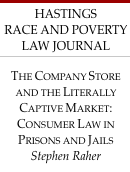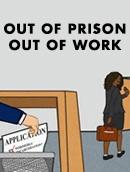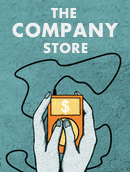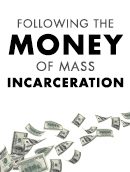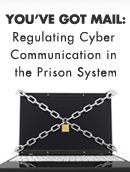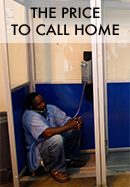This list by prisonpolicy.org is consistently updated with new literature. You can access the list here.
Below, we’ve curated virtually all of the research about the various economic factors of incarceration.
How much does the criminal justice system cost, and who pays for it? How well-funded are prisons and jails? What are the economic impacts and origins of mass incarceration? Do certain programs in prison affect people’s economic well-being after release? See the reports below to explore these questions and more. You can also see related research on our Poverty and Debt page.
Key Statistics:
- Total U.S. government expenses on public prisons and jails: $80.7 billion +
- On private prisons and jails: $3.9 billion +
- Growth in justice system expenditures, 1982-2012 (adjusted for inflation): 310% +
- Number of companies that profit from mass incarceration: ~4,000 +
- Annual cost to families of prison phone calls and commissary purchases: $2.9 billion +
- Percent of formerly incarcerated people who are unemployed: 27% +
- Average daily wage of incarcerated workers: $0.86 +
- Average earnings someone loses over their lifetime by being incarcerated: $500,000 +
- Prioritization of carceral spending in U.S. cities: Development of the Carceral Resource Index (CRI) and the role of race and income inequalityBritt Skaathun et al, December, 2022
- (New) Broken Rules: Laws Meant to End Debtors’ Prisons are Failing NebraskansACLU of Nebraska, December, 2022
- Electronic Monitoring Fees: A 50-State Survey of the Costs Assessed to People on E-SupervisionFines and Fees Justice Center, September, 2022
- The Cost of Solitary Confinement: Why Ending Isolation in California Prisons Can Save Money and Save LivesBerkeley Underground Scholars and Immigrant Defense Advocates, July, 2022
- Reimagining Restitution: New Approaches to Support Youth and CommunitiesJuvenile Law Center, July, 2022
- Prison Labor in Arizona: A year-long investigation Paywall 🙁Arizona Republic and KJZZ News, July, 2022
- Captive Labor: Exploitation of Incarcerated WorkersACLU and the University of Chicago Law School Global Human Rights Clinic, June, 2022
- New data on formerly incarcerated people’s employment reveal labor market injusticesPrison Policy Initiative, February, 2022
- Barred from employment: More than half of unemployed men in their 30s had a criminal history of arrestShawn Bushway et al, February, 2022
- Justice-Involved Individuals and the Consumer Financial MarketplaceConsumer Financial Protection Bureau, January, 2022
- Beyond Payment Plans: Breaking the Cycle of Court Debt in TennesseeThink Tennessee, December, 2021
- Methods of Calculating the Marginal Cost of Incarceration: A Scoping ReviewStuart John Wilson and Jocelyne Lemoine, December, 2021
- The Paid Jailer: How Sheriff Campaign Dollars Shape Mass IncarcerationCommon Cause and Communities for Sheriff Accountability, December, 2021
- Employment of Persons Released from Federal Prison in 2010Bureau of Justice Statistics, December, 2021
- Time for Justice: The Urgent Need for Second Chances In Pennsylvania’s Sentencing SystemFamilies Against Mandatory Minimums, November, 2021
- Police Foundations: A Corporate-Sponsored Threat to Democracy and Black LivesColor of Change and LittleSis, October, 2021
- Blood from a stone: How New York prisons force people to pay for their own incarcerationTommaso Bardelli, Zach Gillespie and Thuy Linh Tu, October, 2021
- The predatory dimensions of criminal justiceJoshua Page and Joe Soss, October, 2021
- The Golden Key: How State-Local Financial Incentives to Lock Up Kentuckians Are Perpetuating Mass IncarcerationKentucky Center for Economic Policy, October, 2021
- Electronic Prisons: The Operation of Ankle Monitoring in the Criminal Legal SystemKate Weisburd et al., September, 2021
- Justice-involved Individuals in the Labor Market since the Great RecessionKeith Finlay and Michael Mueller-Smith, September, 2021
- Debt to Society: The Role of Fines & Fees Reform in Dismantling the Carceral StateWesley Dozier and Daniel Kiel, September, 2021
- Effect of Juvenile Justice Fee Repeal on Financial Sanctions Borne by FamiliesJaclyn E. Chambers, Karin D. Martin, and Jennifer L. Skeem, September, 2021
- Bloody Lucre: Carceral Labor and Prison ProfitLaura I. Appleman, August, 2021
- Inmates May Work, But Don’t Tell Social SecurityStephanie Hunter McMahon, July, 2021
- No KickbacksParole Illinois, June, 2021
- What families can expect to be charged under the new FCC rulesPrison Policy Initiative, June, 2021
- Jails, Sheriffs, and Carceral PolicymakingAaron Littman, May, 2021
- Empire State of IncarcerationVera Institute of Justice, May, 2021
- What Jails Cost: A Look at Spending in America’s Large CitiesVera Institute of Justice, April, 2021
- How Much Criminal Justice Debt Does the U.S. Really Have?Fines & Fees Justice Center, April, 2021
- The People’s Plan for Prison ClosureCalifornians United for a Responsible Budget (CURB), April, 2021
- What Doesn’t Get Measured Doesn’t Get Done: A Roadmap for Data Collection and Reporting in the Era of Bail ReformJoanna Thomas, Abdiaziz Ahmed, New York City Criminal Justice Agency, April, 2021
- What Jails Cost Statewide: Spending on Jails Across the Rural-Urban SpectrumVera Institute of Justice, March, 2021
- Paid Your Debt to Society? Court-related Financial Obligations and Community Supervision during the First Year after Release from Prison Paywall 🙁Nathan W. Link, February, 2021
- The Cost of Incarceration in New York State: How Counties Outside New York City Can Reduce Jail Spending and Invest in CommunitiesVera Institute of Justice, January, 2021
- Proliferation of Punishment: The Centrality of Legal Fines and Fees in the Landscape of Contemporary Penology Paywall 🙁Ilya Slavinski and Becky Pettit, January, 2021
- Punishing Relations: How WA DOC’s Collateral Damage and Hidden Costs Imprison FamiliesWashington Corrections Watch, January, 2021
- Prisons and Penny-Pinching: Finding Budget Savings in the Time of COVID-19Texas Public Policy Coalition, January, 2021
- The High Price of Using Justice Fines and Fees to Fund Government in New YorkVera Institute of Justice, December, 2020
- Spend Your Values, Cut Your Losses 2021 Divestment Portfolio: Smart and Safe Justice System Solutions That Put Communities FirstTexas Criminal Justice Coalition, November, 2020
- MA DOC Expenditures and Staffing Levels for Fiscal Year 2020Lifers’ Group Inc., October, 2020
- New York’s Ferguson Problem: How the state’s racist fee system punishes poverty, lacks transparency, and is overdue for reformNo Price on Justice, September, 2020
- Sticker Shock 2020: The Cost of Youth IncarcerationJustice Policy Institute, July, 2020
- Commercialized (In)justice Litigation Guide: Applying Consumer Laws to Commercial Bail, Prison Retail, and Private Debt CollectionNational Consumer Law Center, June, 2020
- The Broad Scope and Variation of Monetary Sanctions: Evidence From Eight StatesSarah Shannon, Beth M. Huebner, Alexes Harris, et al., June, 2020
- The Explosion of Unpaid Criminal Fines and Fees in North CarolinaDuke Law Center for Science and Justice, April, 2020
- Local Labor Market Inequality in the Age of Mass IncarcerationLuke Petach and Anita Alves Pena, 2020
- Paying for Jail: How County Jails Extract Wealth from New York CommunitiesWorth Rises and Brooklyn Community Bail Fund, December, 2019
- The Steep Costs of Criminal Justice Fees and Fines: A Fiscal Analysis of Three States and Ten CountiesBrennan Center for Justice, November, 2019
 The Company Store and the Literally Captive Market: Consumer Law in Prisons and JailsStephen Raher, November, 2019
The Company Store and the Literally Captive Market: Consumer Law in Prisons and JailsStephen Raher, November, 2019- The Price of Taxation by Citation: Case Studies of Three Georgia Cities that Rely Heavily on Fines and FeesInstitute for Justice, October, 2019
- Fees, Fines and Fairness: How Monetary Charges Drive Inequity in New York City’s Criminal Justice SystemNew York City Comptroller, September, 2019
- The 1994 Crime Bill Legacy and Lessons, Part 1: Impacts on Prison PopulationsThe Council on Criminal Justice, September, 2019
- The Hidden Costs of Florida’s Criminal Justice FeesRebekah Diller, Brennan Center for Justice, August, 2019
- Paid in Full: A Plan to End Money Injustice in New OrleansVera Institute of Justice, June, 2019
- Plus a Life Sentence? Incarceration’s Effects on Expected Lifetime Wage GrowthTheodore S. Corwin III and Daniel K. N. Johnson, June, 2019
- The Prison Industrial Complex: Mapping Private Sector PlayersWorth Rises, April, 2019
- Too Poor to Pay: How Arkansas’s Offender-Funded Justice System Drives Poverty & Mass IncarcerationLawyers Committee for Civil Rights Under Law, March, 2019
- No Credit For Time Served? Incarceration and Credit-Driven Crime CyclesAbhay Aneja and Carlos Avenancio-Leon, February, 2019
- Level of Criminal Justice Contact and Early Adult Wage InequalityRobert Apel and Kathleen Powell, February, 2019
- New York Should Re-examine Mandatory Court Fees Imposed on Individuals Convicted of Criminal Offenses and ViolationsNew York City Bar, November, 2018
- Money for Communities, Not Cages: The Case for Reducing the Cook County Sheriff’s Jail BudgetChicago Community Bond Fund, October, 2018
- Socioeconomic Barriers to Child Contact with Incarcerated Parents Paywall 🙁Batya Y. Rubenstein, Elisa L. Toman, Joshua C. Cochran, August, 2018
 Out of Prison & Out of Work: Unemployment among formerly incarcerated peoplePrison Policy Initiative, July, 2018
Out of Prison & Out of Work: Unemployment among formerly incarcerated peoplePrison Policy Initiative, July, 2018 The Company Store: A Deeper Look at Prison CommissariesPrison Policy Initiative, May, 2018
The Company Store: A Deeper Look at Prison CommissariesPrison Policy Initiative, May, 2018- Criminal Justice Administrative Fees: High Pain for People, Low Gain for GovernmentThe Financial Justice Project of San Francisco, May, 2018
- Revisiting Correctional Expenditure Trends in MassachusettsMASSInc, May, 2018
- Workers With Criminal RecordsSociety for Human Resource Management and the Charles Koch Institute, May, 2018
- The Evolving Landscape of Crime and IncarcerationGreenberg Quinlan Rosner Research, April, 2018
- The Prison Industrial Complex Mapping Private Sector PlayersUrban Justice Center, April, 2018
- Work and opportunity before and after incarcerationBrookings Institution, March, 2018
- A Pound of Flesh The Criminalization of Private DebtAmerican Civil Liberties Union, February, 2018
- “Set up to Fail”: The Impact of Offender-Funded Private Probation on the PoorHuman Rights Watch, February, 2018
- Civil Asset Forfeiture: Forfeiting Your RightsSouthern Poverty Law Center, January, 2018
- The Effects of Pretrial Detention on Conviction, Future Crime, and Employment: Evidence from Randomly Assigned JudgesWill Dobbie, Jacob Goldin, and Crystal S. Yang, January, 2018
- Court Fines and Fees: Criminalizing Poverty in North CarolinaNorth Carolina Poverty Research Fund, January, 2018
- Driving on Empty: Payment Plan Reforms Don’t Fix Virginia’s Court Debt CrisisLegal Aid Justice Center, January, 2018
- Tracking the impact of the prison system on the economyPrison Policy Initiative, December, 2017
- Driven by Dollars: A State-By-State Analysis of Driver’s License Suspension Laws for Failure to Pay Court DebtLegal Aid Justice Center, September, 2017
- Access to Health Care and Criminal Behavior: Short-Run Evidence from the ACA Medicaid ExpansionsJacob Vogler, September, 2017
- Back to Business: How Hiring Formerly Incarcerated Job Seekers Benefits Your CompanyThe Trone Private Sector and Education Advisory Council to the American Civil Liberties Union, June, 2017
- Freedom To Thrive: Reimagining safety & security in our communitiesThe Center for Popular Democracy, Law for Black Lives, and the Black Youth Project 100, June, 2017
- Criminal Background Checks and Access to Jobs: A Case Study of Washington, DCUrban Institute, June, 2017
- Getting Tough on Spending: An Examination of Correctional Expenditure in MassachusettsMassINC and the Massachusetts Criminal Justice Reform Coalition, May, 2017
- Using Time to Reduce Crime: Federal Prisoner Survey Results Show Ways to Reduce RecidivismFamilies Against Mandatory Minimums, May, 2017
- The Price of Prisons: Examining State Spending Trends, 2010-2015Vera Institute of Justice, May, 2017
- The Price of Prisons: Examining State Spending Trends, 2010-2015Vera Institute of Justice, May, 2017
- Selling Off Our Freedom: How insurance corporations have taken over our bail systemColor of Change and the American Civil Liberties Union, May, 2017
- The Case for Paid Apprenticeships Behind BarsCenter for American Progress, April, 2017
- The steep cost of medical co-pays in prison puts health at riskWendy Sawyer, Prison Policy Initiative, April, 2017
- How much do incarcerated people earn in each state?Wendy Sawyer, Prison Policy Initiative, April, 2017
- Making Families Pay: The Harmful, Unlawful, and Costly Practice of Charging Juvenile Administrative Fees in CaliforniaStephanie Campos-Bui, Jeffrey Selbin, Hamza Jaka, Tim Kline, Ahmed Lavalais, Alynia Phillips, Abby Ridley-Kerr, University of California Berkeley School of Law, March, 2017
- Pretrial detention costs $13.6 billion each yearPrison Policy Initiative, February, 2017
 Following the Money of Mass IncarcerationPrison Policy Initiative, January, 2017
Following the Money of Mass IncarcerationPrison Policy Initiative, January, 2017- Past Due: Examining the Costs and Consequences of Charging for Justice in New OrleansVera Institute of Justice, January, 2017
- Prisons as Panacea or Pariah? The Countervailing Consequences of the Prison Boom on the Political Economy of Rural TownsJohn M. Eason, January, 2017
- The Economic Burden of Incarceration in the U.S.Institute for Advancing Justice Research and Innovation, October, 2016
- Responsible Prison Project: Reshaping The Texas Prison System for Greater Public SafetyAaron Flaherty, David Graham, Michael Smith, William D Jones, and Vondre Cash, October, 2016
- A Wealth of Inequalities: Mass Incarceration, Employment, and Racial Disparities in U.S. Household Wealth, 1996 to 2011Bryan L. Sykes, University of Washington and Michelle Maroto, University of Alberta, October, 2016
- Confronting Criminal Justice Debt: A Guide for Policy ReformCriminal Justice Policy Program at Harvard Law School, September, 2016
- Who Pays for Government? Descriptive Representation and Exploitative Revenue SourcesMichael W. Sances and Hye Young You, September, 2016
- Evaluation of Strategies to Reduce Louisiana’s Incarceration Rate and Costs for Nonviolent OffendersLouisiana Legislative Auditor, August, 2016
- Community Cages: Profitizing community corrections and alternatives to incarcerationAmerican Friends Service Committee, August, 2016
- Get To Work or Go To Jail: Workplace Rights Under ThreatUCLA Labor Center, April, 2016
- The Crippling Effect of Incarceration on WealthPrison Policy Initiative, April, 2016
- Economic Perspectives on Incarceration and the Criminal Justice SystemWhite House Council of Economic Advisers, April, 2016
- Unlicensed & Untapped: Removing Barriers to State Occupational Licenses for People with RecordsNational Employment Law Project, April, 2016
- A National Picture of Prison Downsizing StrategiesThe RAND Corporation, February, 2016
- Locked Up & Shipped Away: Interstate Prisoner Transfers and the Private Prison Industry Winter 2016 UpdateGrassroots Leadership, January, 2016
 You’ve Got Mail: The promise of cyber communication in prisons and the need for regulationPrison Policy Initiative, January, 2016
You’ve Got Mail: The promise of cyber communication in prisons and the need for regulationPrison Policy Initiative, January, 2016- In Jail & In Debt: Ohio’s Pay-to-Stay FeesACLU of Ohio, November, 2015
- Corrections Spending Through the State Budget Since 2007-08: Still High Despite Recent ReformsCalifornia Budget & Policy Center, November, 2015
- Prison Price Tag: The High Cost of Wisconsin’s Corrections PoliciesWisconsin Budget Project, November, 2015
- Policing for Profit: The Abuse of Civil Asset ForfeitureInstitute for Justice, November, 2015
- Proposition 47 Progress Report: Year One ImplementationStanford Law School Stanford Justice Advocacy Project, October, 2015
- Debtors’ Prisons in New HampshireACLU of New Hampshire, September, 2015
- Who Pays? The True Cost of Incarceration on FamiliesElla Baker Center for Human Rights; Forward Together; Research Action Design, September, 2015
- Charging Inmates Perpetuates Mass IncarcerationBrennan Center for Justice, May, 2015
- Above the Law: An Investigation of Civil Asset Forfeiture in CaliforniaDrug Policy Alliance, April, 2015
- Corrections Infrastructure Spending in CaliforniaPublic Policy Institute of California, March, 2015
 The Right Investment?: Corrections Spending in Baltimore CityJustice Policy Institute; Prison Policy Initiative, February, 2015
The Right Investment?: Corrections Spending in Baltimore CityJustice Policy Institute; Prison Policy Initiative, February, 2015- Corrections Statistics by StateNational Institute of Corrections, February, 2015
- Justice Expenditure And Employment Extracts, 2012Bureau of Justice Statistics, February, 2015
- Department of Corrections Colorado Correctional Industries Performance AuditColorado Office of the State Auditor, January, 2015
- Public Research Universities: Changes in State FundingAmerican Academy of Arts & Sciences, 2015
- To Serve and Collect: The Fiscal and Racial Determinants of Law EnforcementMichael D. Makowsky, Thomas Stratmann, and Alexander T. Tabarrok, 2015
- “Money Bail”: Making Ohio a More Dangerous Place to LiveThe Buckeye Institute, 2015
- Defunding State PrisonsSanta Clara University School of Law, December, 2014
- One Strike and You’re Out: How We Can Eliminate Barriers to Economic Security and Mobility for People with Criminal RecordsCenter for American Progress, December, 2014
- The Rise in State Prison PopulationsCenter on Budget and Policy Priorities, December, 2014
- Cost-Benefit Analysis and Justice Policy ToolkitVera Institute of Justice, December, 2014
- Justice Reinvestment in North Carolina: Three Years LaterThe Council of State Governments Justice Center, November, 2014
- Changing Priorities: State Criminal Justice Reforms and Investments in EducationCenter on Budget and Policy Priorities, October, 2014
- Justice Assistance Grant (JAG) Program, 2014Bureau of Justice Statistics, August, 2014
- State Government Indigent Defense Expenditures, FY 2008-2012 – UpdatedBureau of Justice Statistics, July, 2014
- Justice Expenditure And Employment Extracts, 2011 – PreliminaryBureau of Justice Statistics, July, 2014
- Justice Expenditure And Employment Extracts, 2009 FinalBureau of Justice Statistics, July, 2014
- Indigent Defense Services In The United States, FY 2008-2012 – UpdatedBureau of Justice Statistics, July, 2014
- Justice Expenditure And Employment Extracts, 2010 FinalBureau of Justice Statistics, July, 2014
- A New Approach to Reducing Incarceration While Maintaining Low Rates of CrimeThe Hamilton Project, May, 2014
- Follow the Money: How California Counties Are Spending Their Public Safety Realignment FundsStanford Criminal Justice Center, January, 2014
- Justice Reinvestment Initiative State Assessment ReportUrban Institute, January, 2014
- The Burden of Criminal Justice Debt in Alabama: 2014 Participant Self-Report SurveyUAB TASC Jefferson County’s Community Corrections Program, 2014
- Local Government Corrections Expenditures, FY 2005-2011U.S. Department of Justice, December, 2013
- Reforming Funding to Reduce Mass IncarcerationBrennan Center for Justice, November, 2013
- Funding Public Safety RealignmentPublic Policy Institute of California, November, 2013
- The Impact of Federal Budget Cuts from FY10-FY13 on State and Local Public SafetyVera Institute of Justice, November, 2013
- Managing Prison Health Care SpendingThe Pew Charitable Trust, The MacArthur Foundation, October, 2013
- Criminals and Campaign Cash The Impact of Judicial Campaign Spending on Criminal DefendantsCenter for American Progress, October, 2013
- Realigning the Revolving Door: An Analysis of California Counties’ AB 109 2011-2012 Implementation PlansStanford Law School Criminal Justice Center, September, 2013
- State Spending for Corrections: Long-Term Trends and Recent Criminal Justice Policy ReformsNational Association of State Budget Officers, September, 2013
- Criminal: How Lockup Quotas andIn the Public Interest, September, 2013
- Treatment of the Highest-risk Offenders Can Avoid CostsOregon Secretary of State, August, 2013
- The Effect of Immigration Detainers in a Post-Realignment CaliforniaCJCJ, August, 2013
 Please Deposit All of Your Money: Kickbacks, Rates, and Hidden Fees in the Jail Phone IndustryPrison Policy Initiative, May, 2013
Please Deposit All of Your Money: Kickbacks, Rates, and Hidden Fees in the Jail Phone IndustryPrison Policy Initiative, May, 2013- Wisconsin’s Mass Incarceration of African American Males: Workforce Challenges for 2013Employment and Training Institute, University of Wisconsin, April, 2013
- The Outskirts of Hope: How Ohio’s Debtors’ Prisons Are Ruining Lives and Costing CommunitiesACLU of Ohio, April, 2013
- Crime, Cost, and Consequences: Is it Time to Get Smart on Crime?MassInc, Community Resources for Justice, March, 2013
- Rationing Justice: The Underfunding of Assigned Counsel Systems — A 50-State Survey of Trial Court Assigned Counsel RatesNational Association of Criminal Defense Lawyers, March, 2013
- The War on Drugs: Undermining peace and securityInternational Drug Policy Consortium, February, 2013
- Policing and the Economic Downturn Striving for Efficiency Is the New NormPolice Executive Research Forum, February, 2013
- The Federal Prison Population Buildup: Overview, Policy Changes, Issues, and OptionsCongressional Research Service, January, 2013
- State Expenditure Report Examining Fiscal 2011-2013 State SpendingNational Association of State Budget Officers, 2013
- Sheriffs’ Offices, 2007Bureau of Justice Statistics, December, 2012
- Report to the Governor and Legislative Budget Board on the Monitoring of Community Supervision Diversion FundsTexas Department of Criminal Justice, December, 2012
- State Corrections Expenditures, FY 1982-2010Bureau of Justice Statistics, December, 2012
- Bail Fail Why the U.S. Should End the Practice of Using Money for BailJustice Policy Institute, September, 2012
 The Price to Call Home State-Sanctioned Monopolization in the Prison Phone IndustryPrison Policy Initiative, September, 2012
The Price to Call Home State-Sanctioned Monopolization in the Prison Phone IndustryPrison Policy Initiative, September, 2012- Trends in Juvenile Justice State Legislation 2001-2011National Conference of State Legislatures, June, 2012
- At America’s Expense The Mass Incarceration of the ElderlyACLU, June, 2012
- Squeeze Play The history of canteen prices and inmate payThe Prison Mirror, May, 2012
- Justice Reinvestment in Pennsylvania A Comprehensive Public Safety Plan for the CommonwealthCouncil of State Governments Justice Center, May, 2012
- A Juvenile Justice Reprieve: California’s 2012 Mid-Year BudgetCenter on Juvenile and Criminal Justice, May, 2012
- The Costs and Benefits of Community-Based Substance Abuse Treatment in the District of ColumbiaUrban Institute, April, 2012
- Justice Assistance Grant (JAG) Program, 2011Bureau of Justice Statistics, March, 2012
- Reallocating Justice Resources A Review of 2011 State Sentencing TrendsVera Institute of Justice, March, 2012
- Improving Budget Analysis of State Criminal Justice Reforms A Strategy for Better Outcomes and Saving MoneyCenter on Budget and Policy Priorities and the American Civil Liberties UNion, January, 2012
- The Price of Prisons What Incarceration Costs TaxpayersVera Institute of Justice, January, 2012
- State Expenditure Report Examining Fiscal 2010-2012 State SpendingNational Association of State Budget Officers, 2012
- Correctional Spending Trends Budget Information ReportOregon Legislative Fiscal Office, September, 2011
- Crisis in the Courts Defining the ProblemAmerican Bar Association, August, 2011
- Inmate Fees as a Source of Revenue Source of ChallengesMassachusetts Executive Office of Public Safety and Security, July, 2011
- System Overload The Costs of Under-Resourcing Public DefenseJustice Policy Institute, July, 2011
- Sentencing Reform Amid Mass Incarceration – Guarded OptimismSentencing Project, May, 2011
- A Billion Dollars and Growing: Why Prison Bonding is Tougher on Florida’s Taxpayers Than on CrimeCollins Center for Public Policy; Florida TaxWatch, April, 2011
- Justice Assistance Grant (JAG) Program 2010Bureau of Justice Statistics, April, 2011
- FY 2010 Operating Per Capita Cost Report Cost Identification and Comparison of State and Private Contract BedsARIZONA DEPARTMENT OF CORRECTIONS, April, 2011
- 65 Million The Case for Reforming Criminal Background Checks for EmploymentThe National Employment Law Project, March, 2011
- Smart on Crime Recommendations for the Administration and CongressThe Smart on Crime Coalition, February, 2011
- Fact Sheet on President Obama’s FY2012 Budget Doing the Same Thing and Expecting Different ResultsJustice Policy Institute, February, 2011
- Banking on Bondage Private Prisons and Mass IncarcerationACLU, 2011
- Justice Assistance Grant Program, 2012Bureau of Justice Statistics, 2011
- Ex-offenders and the Labor MarketCenter for Economic and Policy Research, November, 2010
- The Hidden Costs of Criminal Justice DebtBrennan Center for Justice, October, 2010
- In For a Penny The Rise of America’s New Debtors’ PrisonsAmerican Civil Liberties Union, October, 2010
- The Continuing Fiscal Crisis in Corrections Setting a New CourseVera Institute of Justice, October, 2010
- Collateral Costs Incarceration’s Effect on Economic MobilityPew Charitable Trust, Economic Mobility Project, September, 2010
- Department of Corrections-Prison Population Growth A Report to the Arizona LegislatureState of Arizona Office of the Auditor General, September, 2010
- Drawing Blood from Stones: Legal Debt and Social Inequality in the Contemporary United StatesAlexes Harris, Heather Evans, and Katherine Beckett, University of Washington, May, 2010
- Fact Sheet on FY2010 Department of Justice BudgetJustice Policy Institute, May, 2009
- The Costs of Confinement Why Good Juvenile Justice Policies Make Good Fiscal SenseJustice Policy Institute, May, 2009
- Pruning Prisons How Cutting Corrections Can Save Money and Protect Public SafetyJustice Policy Institute, May, 2009
- One in 31: The Long Reach of American CorrectionsThe Pew Center on the States, March, 2009
- The Impact of Mass Incarceration on PovertyCrime and Delinquency, February, 2009
- Justice Re-investment in New OrleansSpatial Information Design Lab, February, 2009
- Compounded Disadvantage Race, Incarceration, and Wage GrowthNational Poverty Center, October, 2008
- Profiting from the Poor A Report on Predatory Probation Companies in GeorgiaSouthern Center for Human Rights, July, 2008
- Repaying DebtsJustice Center, October, 2007
- State Funding for Corrections in FY 2006 and FY 2007National Conference of State Legislatures, May, 2007
- Impacts of Jail Expansion in New York State: A Hidden BurdenCenter for Constitutional Rights, May, 2007
- Public Safety, Public Spending: Forecasting America’s Prison Population 2007-2011Public Safety Performance Project of The Pew Charitable Trusts, February, 2007
- Toxic Sweatshops: How UNICOR Prison Recycling Harms Workers, Communities, the Environment, and the Recycling IndustryPrison Activist Resource Center, October, 2006
- Saving Futures, Saving Dollars The Impact of Education on Crime Reduction and EarningsAlliance for Excellent Education, September, 2006
- Task Force on California Prison CrowdingNational Council on Crime and Delinquency, August, 2006
- Foreign Nationals in Michigan Prisons an examination of the costsCitizens Alliance on Prisons and Public Spending, April, 2006
- Justice Expenditure and Employment in the United States, 2003Bureau of Justice Statistics, April, 2006
- Cost-Effective Youth Corrections Rationalizing the Fiscal Architecture of Juvenile Justice SystemsJustice Policy Institute, March, 2006
- Welfare and Punishment: The relationship between welfare spending and imprisonmentCrime and Society Foundation, 2006
- Fees Paid by Jail Inmates: Fee Categories, Revenues, and Management Perspectives in a Sample of U.S. JailsNational Institute of Corrections, December, 2005
- Offender Work Report, 2004Washington State Jail Industries Board, October, 2005
- The Economics of Juvenile JurisdictionUrban Institute, September, 2005
- Penny-Wise & Pound-Foolish: Assaultive offender programming and Michigan’s prison costsCitizens Alliance on Prisons and Public Spending and American Friends Service Committee, Criminal Justice Program, April, 2005
- Cost-Saving or Cost-Shifting: The Fiscal Impact of Prison Privatization in ArizonaPrivate Corrections Institute, February, 2005
- Protecting the Future: Moderating West Virginia’s Budget CrisisGrassroots Leadership, February, 2005
- Offender Work Report, 2002Washington State Jail Industries Board, 2005
- When Violence Hits Home: How Economics and Neighborhood Play a RoleNational Institute of Justice, September, 2004
- Changing Fortunes or Changing Attitudes? Sentencing and Corrections Reforms in 2003Vera Institute of Justice, August, 2004
- State Prison Expenditures, 2001Bureau of Justice Statistics, June, 2004
- Justice Expenditure and Employment in the United States, 2001Bureau of Justice Statistics, May, 2004
- Locked Up: Corrections Policy in New Hampshire Paper 2: Options for Reducing the Prison Population and the Cost of IncarcerationNew Hampshire Center for Public Policy Studies, February, 2004
- Offender Work Report, 2003Washington State Jail Industries Board, 2004
- Smart On Crime: Positive Trends in State-Level Sentencing and Corrections PolicyFamilies Against Mandatory Minimums, November, 2003
- 2002 State Expenditure ReportNational Association of State Budget Officers, November, 2003
- Dollars, Sentences and Long-Term Public Safety Managing a Fiscal Crisis with a Goal of Long-Term Public SafetyMiddle Ground Prison Reform, September, 2003
- Ohio’s Priorities?Prison Policy Initiative, September, 2003
- Upstate New York’s Population Plateau: The Third-Slowest Growing ‘State’Brookings Institution, August, 2003
- Dollars and Sentences: Legislators’ Views on Prisons, Punishment, and the Budget CrisisVera Institute of Justice, July, 2003
- Corporate Strategies for Electronics Recycling: A Tale of Two SystemsSilicon Valley Toxics Coalition, June, 2003
- EPA helps prisons get up to speed on environmental complianceEnvironmental Protection Agency, June, 2003
- Drug Policies in the State of Michigan: Economic EffectsJustice Policy Institute, May, 2003
- Borrowing Against the Future: The Impact of Prison Expansion on Arizona Families, Schools and CommunitiesGrassroots Leadership and Arizona Advocacy Network, April, 2003
- Big Prisons, Small Towns: Prison Economics in Small Rural AmericaSentencing Project, February, 2003
- Cutting Correctly in MarylandJustice Policy Institute, February, 2003
- Incarceration and Correctional Spending in Colorado A Legislator’s Handbook on Criminal Justice Policy, 2003Colorado Criminal Justice Reform Coalition, February, 2003
- Building Bridges: From Conviction to Employment A Proposal to Reinvest Corrections Savings in an Employment InitiativeCouncil of State Governments, January, 2003
- Cutting Correctly, One Year Later: State Budget Crisis and Corrections ReformJustice Policy Institute, January, 2003
- The Economic Impacts of the Prison Development Boom On Persistently Poor Rural PlacesTracey Farrigan and Amy Glasmeier, 2003
- Spending More on Prisons than Higher EducationMassachusetts Taxpayers Foundation, 2003
- Seeking Balance: Reducing Prison Costs in Times of AusterityCenter on Juvenile and Criminal Justice, December, 2002
- Community Corrections in Ohio: Cost Savings and Program EffectivenessPolicy Matters Ohio and Justice Policy Institute, December, 2002
- Building a prison economy in rural AmericaTracy Huling, October, 2002
- Blueprint for Cost-Effective Pretrial Detention, Sentencing, and Corrections SystemsAmerican Bar Association, August, 2002
- State Expenditure Report, 2001National Association of State Budget Officers, July, 2002
- California Voters’ Reaction to Proposed Cuts in the BudgetCalifornia HealthCare Foundation, July, 2002
- Cutting Correctly: New Prison Policies for Times of Fiscal CrisisJustice Policy Institute, February, 2002
- State Sentencing and Corrections Policy in an Era of Fiscal RestraintSentencing Project, February, 2002
- Justice Expenditure and Employment in the United States, 1999Bureau of Justice Statistics, February, 2002
- Prison Expansion in a Time of Austerity: An Analysis of the Governor’s Proposed New Prison in DelanoCenter on Juvenile and Criminal Justice, January, 2002
- Offender Work Report, 2001Washington State Jail Industries Board, 2002
- UNICOR 2001 Annual ReportBureau of Prisons, 2002
- Jail Breaks: Economic Development Subsidies Given to Private PrisonsGood Jobs First, October, 2001
- Locked Up: Corrections Policy in New Hampshire Paper 1: The Fiscal Consequences of Incarceration Policies, 1981 to 2001New Hampshire Center for Public Policy Studies, September, 2001
- Offender Work Report, 2000Washington State Jail Industries Board, 2001
- Justice Expenditure and Employment in the United States, 1995Bureau of Justice Statistics, November, 1999
- Regulating the American Labor Market: The Role of the Prison Industrial ComplexDavid Ladipo, September, 1999
- State Prison Expenditures, 1996Bureau of Justice Statistics, August, 1999
- Prisons as a Growth Industry in Rural America: An Exploratory Discussion of the Effects on Young African American Men in the Inner CitiesTracy Huling, consultant to the U.S. Commission on Civil Rights, April, 1999
- Cost Savings in State Corrections: Medical treatment in the community for very ill offenders.Washington State Sentencing Guidelines Commission, December, 1998
- New York State of Mind?: Higher Education vs. Prison Funding in the Empire State, 1988-1998Justice Policy Institute, December, 1998
- The Prison Industrial ComplexEric Schlosser, Atlantic Monthly, December, 1998
- Class Dismissed: Higher Education vs. Corrections During the Wilson YearsJustice Policy Institute, September, 1998
- U.S. Prison Spending Increases Faster than College Funding 1977-1995ABC News, July, 1998
- Is Maryland’s System of Higher Education Suffering Because of Prison Expenditures?Justice Policy Institute, March, 1998
- Truth In Sentencing: Availability of Federal Grants Influenced Laws in Some StatesGeneral Accounting Office, February, 1998
- Justice Expenditure and Employment Extracts, 1992Bureau of Justice Statistics, January, 1997
- Factories with Fences: The History of Federal Prison IndustriesBureau of Prisons, May, 1996
- Rural Prisons: An UpdateCalvin Beale, Department of Agriculture, Rural Development Perspectives, February, 1996
- Federal and State Prisons: Inmate Populations, Costs, and Projection Models, 1996General Accounting Office, 1996
- Prison as IndustryNew York State Coalition for Criminal Justice, 1994
- Prisoner Labor: Perspectives on Paying the Federal Minimum WageGeneral Accounting Office, May, 1993
- Justice Expenditure and Employment, 1990Bureau of Justice Statistics, September, 1992
- The State Expenditure ReportNational Association of State Budget Officers, July, 1987
- The Private Sector and Prison IndustriesNational Institute of Justice, August, 1985

